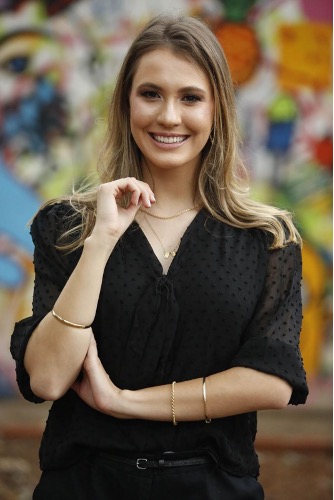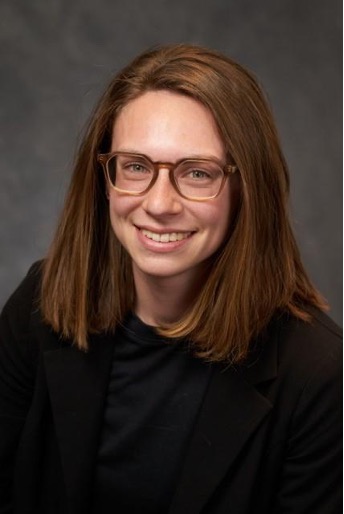
Beatriz B. Cypriano is a first-year Master of Science student in the Design, Energy, and Futures program in the School of Architecture at Syracuse University, working alongside Professor Bess Krietmeyer on projects including the Net Zero Energy Retrofits exhibit at the Museum of Science and Technology (MOST) in Syracuse. Beatriz is originally from Brazil and previously earned her Bachelor’s degree in Architecture and Urbanism at the State University of Maringá in 2021. In August 2023, she started her Masters studies at Syracuse University.
Beatriz’s research with Professor Krietemeyer aligned with her ultimate study and research goals. At the MOST, Beatriz found the tasks very hands-on, different from what she had done in the past. She took part in the making of the exhibition – a room-sized physical model – that shows the results of the team’s research. Beatriz found the biggest highlight to be how the exhibition focuses on teaching the audience about the research results. “Usually, when we think about research, it tends to be difficult to explain to someone else. But the MOST was able to showcase the results to kids and young adults,” Beatriz explains.
Real-World Prep: “The biggest thing would be teamwork. We have a big team of research interns in the School of Architecture working on different model iterations. If it were not for their help, guidance, and teamwork, we would not be able to have achieved the results we had in the end. There was also a lot of interdisciplinary work, where we learned to work with people from other fields. As architects, we did not know much about model projection, so we would have to communicate with the tech and engineer guys. I learned a lot from this, as it has taught me how to work within different disciplines. And of course, I learned to work with deadlines and different institutions with my experience at the exhibition.”
Takeaway: “My biggest takeaway would be the leadership. Every time [I am] at the CoE, even when I do simple tasks, I receive great guidance and networking opportunities from the people there. They connect me with different people in Syracuse. This is how I see and envision leadership – helping others to connect, helping others to grow, and opening doors for your students. I felt like I was exposed to a lot of great things.”
Highlight: “I would definitely say Professor Krietemeyer – she will actually be my thesis instructor for my Master’s capstone. Therefore, we will have some more time together! I admire her as a professional, woman, and architect, so I will definitely miss her and her guidance. She inspires me to go into more research.”
SyracuseCoE Favorites: “Last semester, I spent most of my time in the High Bay lab area where we worked on the big model. I was painting, taking pictures, and creating films of the model. I also did some measurements for different rooms at the CoE headquarters for Professor Krietemeyer’s MOST project. However, the High Bay area is definitely the place I spent the most time in. I really enjoyed the event where private companies and institutions visited to grow partnerships and projects. All the students presented their research to the companies. It was nice to be able to talk to people and learn more about their research.”

Emily Lane is a Master of Architecture student and research assistant at Syracuse University, working alongside Professor Bess Krietmeyer on projects including the Advanced Building Construction (ABC) Project, supported by the U.S. Department of Energy and NYSERDA. Emily had previously obtained her bachelor’s degrees in Chemistry and German Studies at Furman University, encouraging her to explore many interdisciplinary subjects related to the field of architecture.
Previous to working at the SyracuseCoE, Emily worked as an Inorganometallic researcher with Dr. Paul Wagenknecht at Furman University. There, she studied novel photovoltaic molecules for dye-sensitized solar cells. Now studying and working at the School of Architecture, Emily’s work transitioned into an architectural focus. “My work with Bess Krietemeyer allowed me to explore sustainable systems at the building scale. I love architectural work because it requires designers to grapple with a project at both the molecular level and the urban scale,” Emily says.
Having worked on the ABC project for the past few years, Emily found it very exciting to stay involved in multiple stages of the project, including inter-team presentations, documentation, communication with student residents, and schematic designs for construction management and phasing. Emily thinks that witnessing the work evolve from ideation to construction is one of the most exciting aspects of this type of project.
Real-World Prep: “Architecture school has taught me how to engage academically with the built environment, but the CoE has taught me how to work in the built environment. Just being involved in the weekly team coordination meetings and documentation taught me so much about how a project evolves from schematic design to construction. There is so much interdisciplinary coordination and communication that goes into every design decision and it’s been a beautiful thing to be a part of.”
Takeaway: “I’ve learned so much about how much coordination and communication goes into every decision, and all the steps of permitting and code that make construction possible. I owe so much of my understanding of architectural professional practice to my work at the CoE.”
Highlight: “I am extremely grateful for all the experience and connections I made at the Syracuse CoE. It was an amazing experience working with Bess Krietemeyer and Paul McCarthy. Both of them helped me build the foundation for the rest of my career and I’ll miss getting to see them on a regular basis. Paul, thank you for teaching me about facility management, your infectious enthusiasm and always talking about hiking mountains with me. Bess, I knew from my first class with you all I wanted was to be able to work with you someday. You are a constant inspiration in who you are as an architect, professor, and person.”
SyracuseCoE Favorites: “My first introduction to the CoE was through a presentation in Bess Krietemeyer’s Introduction to Systems course about the novel systems of the Center of Excellence Building, and since then, it’s been my favorite space to work. Paul McCarthy used to let me just do my homework upstairs in the lab space because I loved it so much. The Center of Excellence is such a good balance of a quiet and clean working environment with opportunities for spontaneous interactions with other researchers. My favorite event was the summer Innovation Showcase hearing about all the exciting work produced throughout the summer and getting to help coordinate the event with Loral.”
